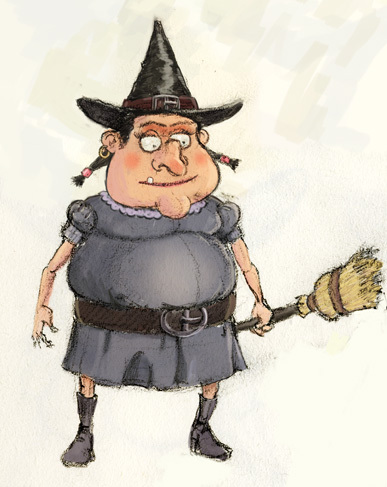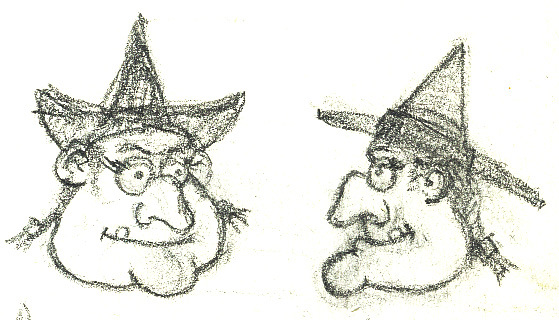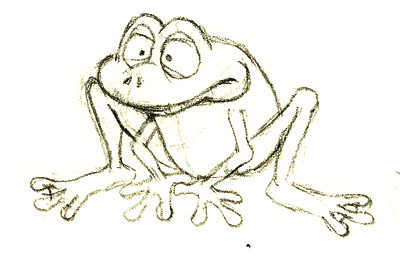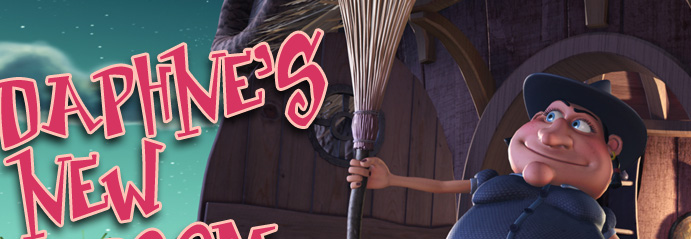 |
Animation Mentor:
How did you come up with the concept for your short film?
Ales Mav:
I started thinking about my short film idea at the end of Class 4. The idea about the witch and her trouble with the broom came suddenly one evening and as I imagined the situation in my head it seemed realIy fun to do. I knew I wanted to do something with the character and setting I felt comfortable with (I always loved witches) and I wanted to have a dynamic story where I could also practice editing a bit and try out different camera situations. Of course I did 4 more scripts when Class 5 started, but "the witch" story was always my favorite, even though I did keep one of those scripts at the back of my head for some other occasion. The idea about adding the frogs came to me during Class 6. I thought it would be a nice addition to include casual observers into the story because it makes the viewer even more aware of how absurd the entire situation actually is. Of course, I didn't let anyone know about these extra characters, because my short was very long already and I wanted to polish what I had so far. I added the frogs after my Animation Mentor classes ended. They were done very quickly -- modeled and textured in about a day or two. The animation was also very basic.
Animation Mentor:
What important lessons did you learn from making your short film?
Ales Mav:
Planning, planning, planning... Can I say it again? PLANNING. More about it in one of the following answers. Oh, and the important lesson to me was also that we definitely shouldn't make the animation our only point of interest in our lives. We should know how to relax and find peace of mind in other things as well. Especially when you get burned out, (like I did in the last months of short film production) you really need a place to chill out. Find some non-animation activity that relaxes you. I was thinking about my short all the time -- what shots I still have to work on, what would be the best way to handle changes suggested by my mentor, how will I do cloth simulation, worries about the sound... All this kept my nerves on a tight string all the time. I know all this strong focus brought my short to the level it is at now, and I must say I am quite pleased with the way it turned out, but I gotta "Take it easy!" more often with my next short. :) It is a really good thing if you can forget about your work every now and then and just enjoy an hour or a day of pure peace of mind doing whatever you like that keeps your mind off your work: reading, drawing, making a nice meal, knitting...
Animation Mentor:
How long did it take to complete your film?
Ales Mav:
I took one term off after Class 4 to do the modelling and rigging of the main character and most of the environment. Due to the length of my film and the desire to polish the animation as much as I can, I took Class 6 twice. After this it took 2 months to do the rendering, cloth simulation for Daphne's skirt and compositing. Oh, and making the frog :) So altogether it took about a year to do the whole thing from scratch. Part-time that is -- I also have a job.
Animation Mentor:
How much planning was put into your short film? Did planning help make the process easier?
Ales Mav:
Planning was the most important part of short film preproduction in Class 5. This is the part where you can change things very easily at no cost: shuffle storyboard sketches around, try different camera angles in layout, and play with timing in editing. I was lucky to have Pepe Valencia as my Class 5 mentor. He had quite a bit of experience with previz as he also worked on the Quidditch sequence in the first Harry Potter movie. So what better mentor to guide you through preproduction of a flying broom short. :) I really became aware of the importance of planning during this class. You sit down for a few days, draw a bunch of sketches, scan them on a computer and there you have your first version of the short! Yes, it’s very rough, but all the main ideas are there and you can easily see what works and what doesn’t. The rest is just polishing and refining.
As far as planning the actual animation goes I must say I wish I could plan more of it on paper and not so much directly doing the key poses on a computer. But I did have quite clear idea about what I wanted for most of the shots, and if I wasn't sure how to pull something off, I just stepped in front of the mirror and tried it out, for example, the part when she kicks the broom in the swamp. But there were two or three shots where I had some problems due to the lack of planning (changing the animation quite far down the line). Most notably, the shot when Daphne extends her arm as she enjoys the ride. Not doing enough planning was definitely a valuable lesson for me. When I start working on my next shot I promised myself to spend more time with a piece of paper.
Animation Mentor:
Do you mind sharing some of the pre-production work with us with a little explanation of what we’re looking at.
Ales Mav:
Sure. Ha, ha, it's been a while since I've watched this. Here's my pitch, animatic, layout, rough blocking, and blocking plus. As you can see, it took me quite some time to get to the final ending. Also areas of weak planning can clearly be seen. :)
Some sketches I used as a reference with modeling:

This is the sketch I used as a reference when modeling Daphne. As you can see, the final version turned out quite different especially in terms of proportions. This is how I like to work when modeling my own designs. I only use the reference in the early stages of modeling. At one point, I drop the sketch and concentrate on what feels right while turning the model around, scaling different parts of the body up and down, pushing vertices around, etc.
Sketch I used as a reference while modeling the head:

The frog:

Final turntable test of Daphne (without textures):
Animation Mentor:
What obstacles, if any, did you experience during the creation of your short film? How did you work your way around them?
Ales Mav:
Like I mentioned before -- from the animation point of view I had some minor problems due to the lack of planning so there were places where I was changing animation quite far down the line. Naturally, I also encountered technical difficulties, but thanks to the many years of production experience with Maya it didn't take too long to fix them. Of the areas that had the most chance to go wrong was the cloth simulation for Daphne's skirt, which I didn't get to until the animation was completely done. First, the idea was to do it on a final scene of each shot, but it was so slow that it was impossible to quickly make the numerous play blasts you need to find the right cloth properties. So I found this really neat way to do the cloth simulation in a clean scene by only importing the shot camera, hip animation, and skirt collision objects. Also a huge issue at the end of production was the colors. It all looked nice when I did the final compositing and color correction at home. But when I watched it on other displays all those nice colors were gone. Only some strange washed muddy hues of green and red were present. Whaaa! I realized that my home display was tuned towards blue. So I ended up with an extra adjustment layer in After Effects where I cranked up the contrast and added much more blue color to my rendered images.
Animation Mentor:
Tell how your Animation Mentor experience helped you in creating your short film.
Ales Mav:
I could never bring my short film to the level it is at without the professional support, inspiration, and guidance of Animation Mentor mentors. Soaking it all in and combining it with hard work made all this one of the best choices of my life. I have had a decade old wish to make my own short film. A lack of animation knowledge was the main thing that stood in the way of realizing my goal. And now here it is... I still can't believe it's done. Without Animation Mentor I could really only dream to have my short mentored by animators from a professional animation studio such as Pixar. Thank you Pepe Valencia, Bret Parker and Brett Schulz! Now it's time to move on and explore the endless possibilities of animation as an art form as far as I can. So much left to learn!
|
 |





